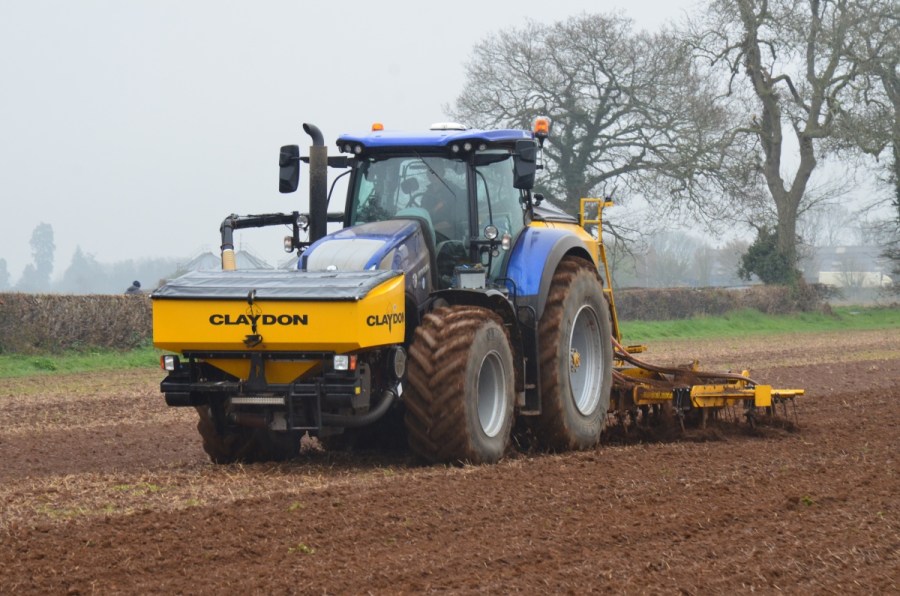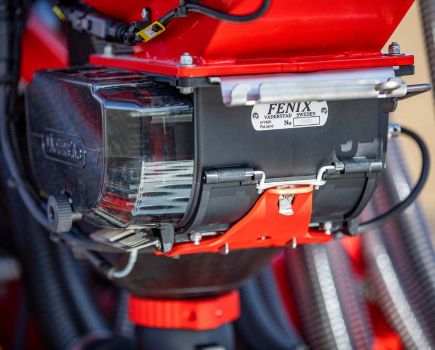Changing his farming system meant changing his drill for an Oxfordshire farmer. CPM finds out what drove him to seek more versatility from his machinery.
When you begin looking at the soil as the solution to tackling blackgrass, you start to unravel one of the most complex and fascinating living organisms on Earth
By Rob Jones
Versatility was the key factor which determined the choice of drill for Adrian Taylor, who farms on the Oxfordshire/Northamptonshire border just outside the aptly named village of Claydon, five miles north of Banbury.
Adrian farms 750ha at Clattercote Priory, of which 170ha are owned and 580ha are on stubble-to-stubble contracts within a 12-mile radius. Though mainly arable, the farm also operates a bed and breakfast pig enterprise, a small Aberdeen Angus suckler herd, together with holiday let cottages attached to the Priory house.
“In terms of soil types, we have a mix of everything here, from ironstone to Warwickshire clay,” explains Adrian. “Strip seeding has been used for the past eight years and now the plough only comes out as a last resort, specifically if there’s an issue with meadow grass or sterile brome.
“We began strip seeding in 2014 with another make of strip till drill, a 4m Mzuri trailed unit which was cumbersome to operate in smaller fields, very heavy and needed a lot of power. Even the 360hp/400hp Caterpillar we had at the time struggled to pull it.
He also found it was expensive on wearing metal and couldn’t handle difficult conditions, so it came to a halt when the weather turned wet. “When that happened in autumn 2015, we borrowed a Claydon Hybrid from P A Turney at Middleton Stoney. Its versatility and ability to deal with varying soil types and conditions persuaded us to change.”
Adrian decided to purchase a 4.8m Claydon Hybrid in spring 2016, a mounted unit with 15 seeding tines which he chose for its greater manoeuvrability, an important consideration with field sizes from 3.5ha to 23ha.
The standard set up incorporates Claydon’s leading in-line tine design which alleviates compaction and creates drainage and tilth in the seeding and rooting zone. This leaves the soil profile intact and provides an ideal growing environment.
Adrian’s drill set-up also features a 1750-litre front-mounted tank. Not only does this double the seed carrying capacity during the busy autumn period but it also allows DAP fertiliser to be applied, either above the seed or below it, when drilling spring oats and linseed.
The new drill has lived up to expectations as Adrian finds the Claydon is easier to operate in small fields and to move from farm to farm than the previous trailed unit. When it arrived, Adrian sold the 360hp Caterpillar and since then has come to appreciate the Hybrid’s ease of use, lack of complexity and low operating costs. Despite being slightly less powerful than the previous Caterpillar, the farm’s current 315hp New Holland T7.315 tractor handles the Claydon Hybrid well, pulling it at up to 12km/h, he says.
This season, Adrian is growing 360ha of winter milling wheat, with 120ha of Group 1 Skyfall on contract to Warburtons, the largest bakery business in the country which contracts over 150,000 tonnes of quality milling wheat in Britain each year. The remainder is Group 3 biscuit varieties. In addition, he has 110ha of winter beans, 72ha of OSR, 94ha of spring linseed, 92ha of spring oats on a low-gluten contract, together with 8ha of herbal ley and 4ha of wildflower meadow.
Average yields on the farm are 9t/ha for wheat, 5.5t/ha for winter beans, 2.4t/ha for spring linseed and 6.4t/ha for spring oats.
“Since we introduced the Claydon Opti-Till System, our soils have become much easier to work and drain much better,” he explains. “On heavier clays we sometimes use a He-Va Stealth low-disturbance subsoiler in front of the drill, but you have to know when some soil conditioning is needed. You also have to recognise when you shouldn’t drill, because the Claydon Hybrid will travel even when you shouldn’t be there,” he highlights.
Under his now regenerative farming system, soil health is improving and that brings many benefits, says Adrian. “Our soils have also become much more supportive, so they carry the weight of following machinery much better without becoming rutted, as was the case when we ploughed. This is important because our 24m Sands Vision sprayer goes through the wheat up to seven times and the 24m Kuhn Axera H-EMC fertiliser spreader is used up to three times.
“The top layer is improving, yields are stable, establishment costs are under control and worm counts have gone from just two or three in a spade full of soil, to 30-40 worms. Keeping traffic off the field is a vital part of the approach,” he says.
“We leave about 25cm of stubble behind our 2017 New Holland CR9.80 SmarTrax combine, which runs on 600mm tracks to reduce compaction, then go in with the 7.5m Claydon Straw harrow behind one of our 225hp New Holland T7.260s tractors a week or so later. The Straw Harrow is used two or three times as it’s a cheap, quick way to encourage an early chit of grassweeds and aid slug control. We intend to add a seeder to it to establish cover crops,” adds Adrian.
“Drilling wheat begins during the last couple of days in September on cleaner ground and we aim to finish by the end of October. Seed goes in 20-30mm deep and generally we start with a rate of 300 seeds/m2 and increase that up to 450 seeds/m2 when it’s late, or conditions are cold. Those numbers are higher than for our old intensive tillage system.”
To extend the benefits of the Claydon System, Adrian has added a 4.8m TerraBlade inter-row hoe, which is used on a New Holland T5.120. This gives him an added non-chemical means of controlling blackgrass, and this is working well, he says.
The TerraBlade is a low-cost, mechanical method of controlling weeds in band-sown crops. “It keeps the space between the seeded rows clear of weeds during the initial stages of crop grown, reduces competition for nutrients, light, air, and water, which allows plants to grow away strong and healthy.
“Fuel and metal use has dropped significantly using strip seeding and although our main tractor – the New Holland T7.315 – is doing similar annual hours, it’s covering a much larger area in that time,” adds Adrian. “Fertiliser and chemical use are not noticeably less, but this may change as we get more into regenerative agriculture. No insecticides have been applied for two years.”
A regenerative step
Adrian visited Jeff Claydon’s farm in Suffolk after purchasing the new drill, which is on some very heavy land, and he describes it as time well spent. “Jeff listens to what you say and always wants to improve his company’s products. I learned a lot from that visit.”
Accompanying Adrian was his agronomist, Ben Taylor-Davies, also known as Regen Ben, who favoured the change to strip tillage and encouraged him to adopt a more regenerative approach to farming.
Ben’s ethos is to use sound biological, peer-reviewed methods to produce crops in a way that doesn’t require vast amounts of artificial inputs. A director of the Oxford Farming Conference, Ben owns the 224ha Townsend Farm at Ross-on-Wye, which produces potatoes, oilseed rape, spring barley, winter wheat, winter rye and grass. He says he loves breaking the boundaries of farming techniques, reducing pesticide use and the farm’s carbon footprint, improving soil health and looking after the environment as part of growing nutrient dense high welfare food.
In 2016 Ben became a Nuffield Scholar and his study was based around the control of blackgrass. But, he says, it soon became apparent that he solution to the problem was not herbicides. What was needed was a change in soil management.
“We had created a perfect environment in which blackgrass could thrive by damaging the functionality of soil and causing moisture-holding clay soils to become wetter and wetter. The solution was not to treat the symptoms but the cause.
“The huge yield-robbing effect of blackgrass means that some fields and farms are becoming unfarmable. When you begin looking at the soil as the solution to tackling blackgrass, you start to unravel one of the most complex and fascinating living organisms on Earth, one that is largely ignored. Understanding the complexities of the soil makes you realise that, as a farmer, the very thing you consider to be one of your key assets is the very thing you are destroying,” believes Ben.
“Soil is a living organism, so the key is to limit mechanical, chemical, and physical disturbance of soil. Tillage destroys its structure by constantly tearing apart the ‘house’ which nature builds to protect the living organisms that create natural fertility. Soil structure includes aggregates and pore spaces, so tillage causes erosion and wastes precious natural resource.
“Ploughing has been the mainstay of agriculture for 4000 years, but the problem is that for 3920 years ploughs were pulled by animals. Their limitations meant that this was once only a very shallow operation which kept the soil biology in an aerobic situation, so soils continued to function well,” explains Ben.
“Over the past 80 years – with the anything but ‘green’ revolution – farms became larger, which meant machinery got bigger and heavier. Pulling ever larger ploughs deeper and deeper destroyed the living soil biology, while synthetic fertilisers, herbicides, pesticides, and fungicides all had negative impacts on life in the soil,” he believes.
“The main principles of regenerative farming we’re trying to implement are things nature has formulated well for well over half a billion years. Soil amour keeps soil covered at all times. Living roots put sugar-rich carbon into soils and that feeds the biology naturally. In return, the soil biology provides plants with nutrients that are locked up in the soil.
Ben’s approach is that soil disturbance should be kept to an absolute minimum. “Mother Nature doesn’t plough, add synthetic fertilisers, or use hydrocarbon pesticides. Diversity mixtures of plants and species will reduce the pressure that nature places on a mono-crop system by trying to balance these unnatural environments, invading them with what we call pests, weeds, and diseases.
“Where possible we should integrate livestock and their manures in the system, as nowhere in nature are animals devoid,” he adds.
Farm facts
Clattercote Priory, Claydon, Oxfordshire
- Area: 750ha
- Cropping: winter wheat, winter beans, OSR, spring linseed, spring oats
- Soil type: Ironstone to Warwickshire clay
- Mainline tractors: New Holland T7.315, 315hp; New Holland T7.260, 225hp; New Holland T5.120, 120hp
- Combine: New Holland CR9.80 SmarTrax combine
- Cultivation equipment: 5m Claydon Straw harrow; He-Va Stealth low-disturbance subsoiler; Terra blade inter-row hoe, 4.8m
- Drill: Claydon Hybrid, 4.8m
- Fertiliser spreader: Kuhn Axera H-EMC, 24m
- Sprayer: Sands Vision sprayer, 24m




